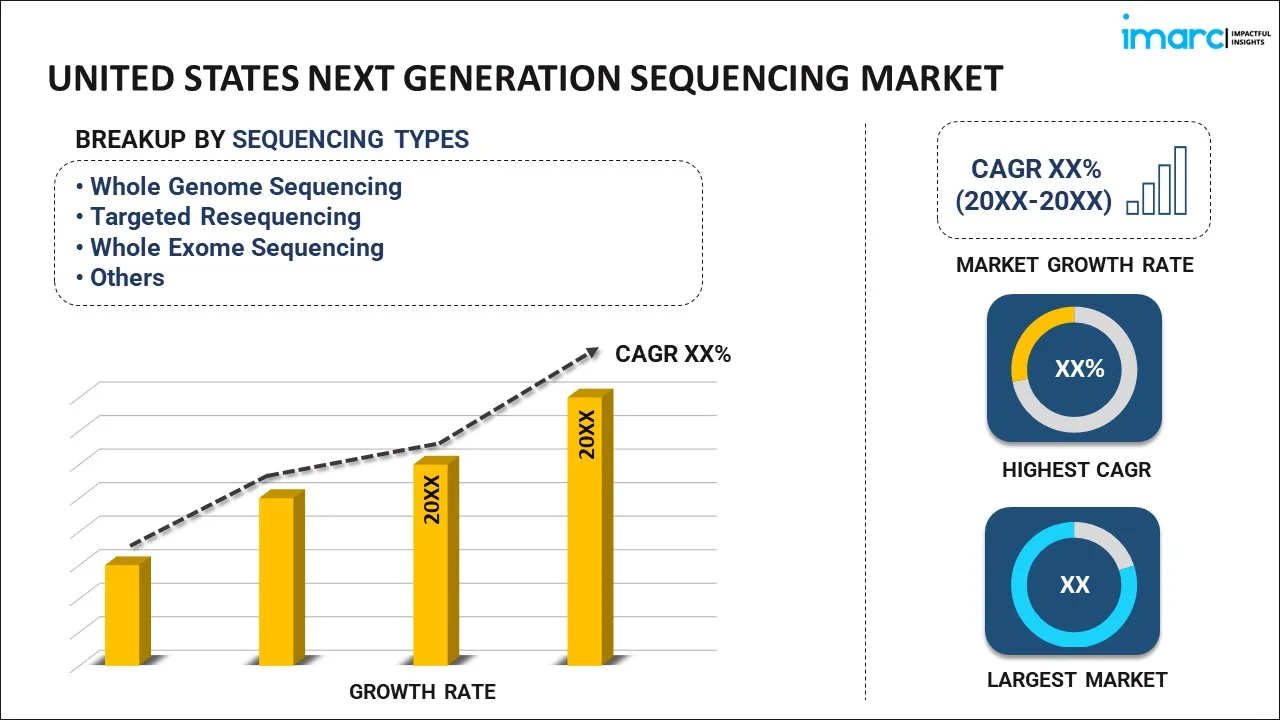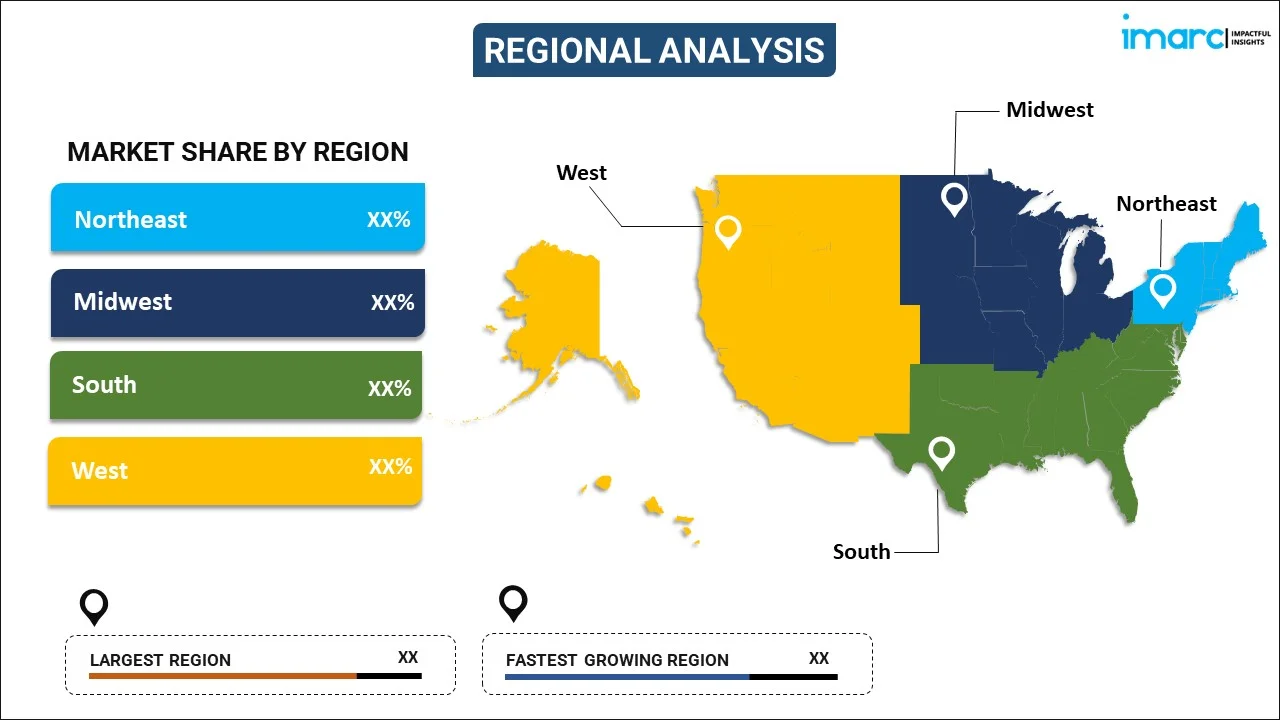
United States Next Generation Sequencing Market Report by Sequencing Type (Whole Genome Sequencing, Targeted Resequencing, Whole Exome Sequencing, RNA Sequencing, CHIP Sequencing, De Novo Sequencing, Methyl Sequencing, and Others), Product Type (Instruments, Reagents and Consumables, Software and Services), Technology (Sequencing by Synthesis, Ion Semiconductor Sequencing, Single-Molecule Real-Time Sequencing, Nanopore Sequencing, and Others), Application (Biomarker and Cancer, Drug Discovery and Personalized Medicine, Genetic Screening, Diagnostics, Agriculture and Animal Research, and Others), End User (Academic Institutes and Research Centers, Hospitals and Clinics, Pharmaceutical and Biotechnology Companies, and Others), and Region 2025-2033
Market Overview:
The United States next generation sequencing market size reached USD 4.4 Billion in 2024. Looking forward, IMARC Group expects the market to reach USD 20.9 Billion by 2033, exhibiting a growth rate (CAGR) of 18.9% during 2025-2033. The increasing demand for personalized medicines among the masses, the rising product adoption in agriculture and environmental research, and various advancements in automation and data analysis represent some of the key factors driving the market.
|
Report Attribute
|
Key Statistics
|
|---|---|
|
Base Year
|
2024 |
|
Forecast Years
|
2025-2033
|
|
Historical Years
|
2019-2024
|
| Market Size in 2024 | USD 4.4 Billion |
| Market Forecast in 2033 | USD 20.9 Billion |
| Market Growth Rate (2025-2033) | 18.9% |
Next generation sequencing (NGS), also known as high-throughput sequencing, is a cutting-edge technology used in molecular biology to determine the precise order of nucleotides (adenine, guanine, cytosine, and thymine) in a DNA or RNA molecule. NGS has revolutionized genomics research, enabling scientists to sequence large volumes of genetic material rapidly and cost-effectively. This technology has numerous applications in fields such as genomics, genetics, personalized medicine, and biomedical research. These platforms can generate vast amounts of sequencing data in a single run. This high throughput is essential for applications like whole-genome sequencing, metagenomics, transcriptomics, and more. There are several NGS platforms available, each with its own technology and chemistry. Some common platforms include Illumina, Ion Torrent (now part of Thermo Fisher Scientific), Pacific Biosciences (PacBio), and Oxford Nanopore Technologies. Each platform has unique advantages and limitations, influencing its suitability for specific applications.
United States Next Generation Sequencing Market Trends:
In the United States, the next generation sequencing market has been experiencing robust growth in recent years, driven by the increasing demand for personalized medicine. Healthcare providers and pharmaceutical companies are increasingly relying on NGS to analyze individual patient genomes, enabling the customization of treatment plans and the development of targeted therapies. This approach enhances patient outcomes and reduces healthcare costs by minimizing the use of ineffective treatments. Another significant trend in the market is the expansion of applications beyond healthcare. The technology is now being widely adopted in agriculture and environmental research. Farmers and scientists use NGS to analyze the genetic makeup of crops and livestock, allowing for the development of more resilient and productive agricultural practices. Additionally, environmental researchers use NGS to study ecosystems, track biodiversity, and monitor environmental changes, contributing to our understanding of ecological dynamics and the impact of human activities on the environment. Besides, the adoption of NGS is also being propelled by advancements in automation and data analysis. As sequencing instruments become more automated and user-friendly, the barrier to entry for laboratories and research facilities is lowering. This accessibility, combined with the increasing availability of bioinformatics tools and software, enables a broader range of organizations to harness the power of NGS technology. Furthermore, government initiatives and funding play a pivotal role in driving the NGS market in the United States. Federal agencies, such as the National Institutes of Health (NIH) and the National Human Genome Research Institute (NHGRI), allocate significant resources to support genomics research and the development of NGS technologies. These investments accelerate scientific discoveries and stimulate innovation and economic growth in the biotechnology sector.
United States Next Generation Sequencing Market Segmentation:
IMARC Group provides an analysis of the key trends in each segment of the market, along with forecasts at the country level for 2025-2033. Our report has categorized the market based on sequencing type, product type, technology, application, and end user.
Sequencing Type Insights:

- Whole Genome Sequencing
- Targeted Resequencing
- Whole Exome Sequencing
- RNA Sequencing
- CHIP Sequencing
- De Novo Sequencing
- Methyl Sequencing
- Others
The report has provided a detailed breakup and analysis of the market based on the sequencing type. This includes whole genome sequencing, targeted resequencing, whole exome sequencing, RNA sequencing, chip sequencing, de novo sequencing, methyl sequencing, and others.
Product Type Insights:
- Instruments
- Reagents and Consumables
- Software and Services
A detailed breakup and analysis of the market based on the product type have also been provided in the report. This includes instruments, reagents and consumables, and software and services.
Technology Insights:
- Sequencing by Synthesis
- Ion Semiconductor Sequencing
- Single-Molecule Real-Time Sequencing
- Nanopore Sequencing
- Others
The report has provided a detailed breakup and analysis of the market based on the technology. This includes sequencing by synthesis, ion semiconductor sequencing, single-molecule real-time sequencing, nanopore sequencing, and others.
Application Insights:
- Biomarker and Cancer
- Drug Discovery and Personalized Medicine
- Genetic Screening
- Diagnostics
- Agriculture and Animal Research
- Others
A detailed breakup and analysis of the market based on the application have also been provided in the report. This includes biomarker and cancer, drug discovery and personalized medicine, genetic screening, diagnostics, agriculture and animal research, and others.
End User Insights:
- Academic Institutes and Research Centers
- Hospitals and Clinics
- Pharmaceutical and Biotechnology Companies
- Others
The report has provided a detailed breakup and analysis of the market based on the end user. This includes academic institutes and research centers, hospitals and clinics, pharmaceutical and biotechnology companies, and others.
Regional Insights:

- Northeast
- Midwest
- South
- West
The report has also provided a comprehensive analysis of all the major regional markets, which include Northeast, Midwest, South, and West.
Competitive Landscape:
The market research report has also provided a comprehensive analysis of the competitive landscape. Competitive analysis such as market structure, key player positioning, top winning strategies, competitive dashboard, and company evaluation quadrant has been covered in the report.
The report provides a comprehensive analysis of the competitive landscape in the United States next generation sequencing market with detailed profiles of all major companies, including:
- Thermo Fisher Scientific Inc.
- Illumina Inc.
- Agilent Technologies, Inc.
- QIAGEN GmbH
- Bio-Rad Laboratories, Inc.
- PerkinElmer Inc.
- Pacific Biosciences of California, Inc.
- Oxford Nanopore Technologies plc
- Eurofins Scientific SE
- Macrogen Inc.
United States Next Generation Sequencing Market Report Coverage:
| Report Features | Details |
|---|---|
| Base Year of the Analysis | 2024 |
| Historical Period | 2019-2024 |
| Forecast Period | 2025-2033 |
| Units | Billion USD |
| Scope of the Report | Exploration of Historical and Forecast Trends, Industry Catalysts and Challenges, Segment-Wise Historical and Predictive Market Assessment:
|
| Sequencing Types Covered | Whole Genome Sequencing, Targeted Resequencing, Whole Exome Sequencing, RNA Sequencing, CHIP Sequencing, De Novo Sequencing, Methyl Sequencing, Others |
| Product Types Covered | Instruments, Reagents and Consumables, Software and Services |
| Technologies Covered | Sequencing by Synthesis, Ion Semiconductor Sequencing, Single-Molecule Real-Time Sequencing, Nanopore Sequencing, Others |
| Applications Covered | Biomarker and Cancer, Drug Discovery and Personalized Medicine, Genetic Screening, Diagnostics, Agriculture and Animal Research, Others |
| End Users Covered | Academic Institutes and Research Centers, Hospitals and Clinics, Pharmaceutical and Biotechnology Companies, Others |
| Regions Covered | Northeast, Midwest, South, West |
| Companies Covered | Thermo Fisher Scientific Inc., Illumina Inc., Agilent Technologies, Inc., QIAGEN GmbH, Bio-Rad Laboratories, Inc., PerkinElmer Inc., Pacific Biosciences of California, Inc., Oxford Nanopore Technologies plc, Eurofins Scientific SE, Macrogen Inc., etc. |
| Customization Scope | 10% Free Customization |
| Post-Sale Analyst Support | 10-12 Weeks |
| Delivery Format | PDF and Excel through Email (We can also provide the editable version of the report in PPT/Word format on special request) |
Key Questions Answered in This Report:
- How has the United States next generation sequencing market performed so far and how will it perform in the coming years?
- What has been the impact of COVID-19 on the United States next generation sequencing market?
- What is the breakup of the United States next generation sequencing market on the basis of sequencing type?
- What is the breakup of the United States next generation sequencing market on the basis of product type?
- What is the breakup of the United States next generation sequencing market on the basis of technology?
- What is the breakup of the United States next generation sequencing market on the basis of application?
- What is the breakup of the United States next generation sequencing market on the basis of end user?
- What are the various stages in the value chain of the United States next generation sequencing market?
- What are the key driving factors and challenges in the United States next generation sequencing?
- What is the structure of the United States next generation sequencing market and who are the key players?
- What is the degree of competition in the United States next generation sequencing market?
Key Benefits for Stakeholders:
- IMARC’s industry report offers a comprehensive quantitative analysis of various market segments, historical and current market trends, market forecasts, and dynamics of the United States next generation sequencing market from 2019-2033.
- The research report provides the latest information on the market drivers, challenges, and opportunities in the United States next generation sequencing market.
- Porter's five forces analysis assist stakeholders in assessing the impact of new entrants, competitive rivalry, supplier power, buyer power, and the threat of substitution. It helps stakeholders to analyze the level of competition within the United States next generation sequencing industry and its attractiveness.
- Competitive landscape allows stakeholders to understand their competitive environment and provides an insight into the current positions of key players in the market.
Need more help?
- Speak to our experienced analysts for insights on the current market scenarios.
- Include additional segments and countries to customize the report as per your requirement.
- Gain an unparalleled competitive advantage in your domain by understanding how to utilize the report and positively impacting your operations and revenue.
- For further assistance, please connect with our analysts.
 Request Customization
Request Customization
 Speak to an Analyst
Speak to an Analyst
 Request Brochure
Request Brochure
 Inquire Before Buying
Inquire Before Buying




.webp)




.webp)












